Explore Valencia
2 Days in Valencia: The Perfect Valencia Itinerary
Published: 09/03/2022
Valencia is one of Spain’s largest cities and top tourist destinations The city is famous for its signature paella, but beyond that it can be a bit of a mystery. So, when you visit the city for a couple days as part of your Spain itinerary, you might not be sure where to start.
That’s where this Valencia itinerary comes in. With our itinerary as a guide you’ll know exactly what to do in Valencia in 2 days to make the most of your time there. You’ll find advice on how to discover the best places to visit in Valencia, and how to tackle it all in two short days.
Best Time to Visit Valencia
To have the best time possible while in Valencia, it’s wise to factor in the best time of year to visit. The weather as well as how busy the city is with tourists can both affect how much you enjoy your visit. And in fact, it’s really that trade off that determines when the best time to visit Valencia is for you.
While Valencia enjoys a pretty comfortable climate with around 300 days of sunshine each year, the best beach weather comes from July to October. However, that’s also the busiest time of year in the city. If you want to visit when there are next to no tourists in Valencia, it’s best to go in the winter months of November through February. The downside there is that some attractions will have reduced opening hours.
For a balance of good weather and fewer tourists, it’s best to visit in spring. From March to June you can expect pleasant weather for sightseeing, without having to worry too much about other tourists being around. That also makes it a good time if you’re on a budget, as demand and prices will be lower than in the summer.
How to Get Around Valencia
When visiting Valencia and its spread out attractions, you’ll want to know the best ways to get around the city. Getting between attractions in the Old Town is easily enough done on foot, but walking all over the city for two days is going to seriously wear you out. So it’s best if you get acquainted with the city’s public transport network for your 48 hours in Valencia.
Recommendation: To save money on public transportation, it’s best to get the Valencia Tourist Card. This card also gives you free entrance to public museums, as well as great discounts in shops, restaurants, and tours.
Valencia’s public transport network is made up of a metro system with six lines, and buses. The standard ticket option for both is a single journey ticket which costs €1.50. Tickets can be bought from machines in metro stations or from bus drivers. There are other ticket types as well, some of which can be used on both the bus and metro.
Recommendation: Another great way to get around in Valencia as a tourist is with the Hop-On Hop-Off Bus. A bus ticket allows you to get on and off at all of the stops around the city for a validity of 24 or 48 hours. There are 21 stops in total which cover all of Valencia’s main attractions. Included in the price is an audio guide in 10 different languages, which gives you some insights into all the key landmarks. You can purchase your hop-on hop-off ticket here. If you intend on visiting the Oceanografic aquarium purchase this combi ticket instead to save some money.
You’ll likely also want to know how to get from Valencia Airport into the city center. Valencia’s airport is located 10km from the city and there are multiple frequent options for travel to the city center via public transport. Firstly, there’s the metro, which costs €4.90 and takes about 20 minutes. Then, there’s the airport shuttle bus which makes the trip in 25 minutes, but only costs €2.50. Finally, there’s the local bus which takes about 40 minutes and is the cheapest option at €1.45.

Where to Stay in Valencia
The biggest challenge when planning a trip is usually working out where to stay in Valencia. In such a big city there’re plenty of districts to choose from and you don’t want to stay somewhere that’s impractical or poor value for money.
In terms of atmosphere, the best places to stay in Valencia are generally found in Valencia’s Old Town. However, staying in Eixample or down in Camins al Grau is also a good option as there are many quality hotels, B&Bs, and apartments there.
For one of Valencia’s most luxurious options, the Hospes Palau de La Mar is the way to go. Set inside a 19th century building, this five-star hotel is just a 10 minute walk from the heart of the city and boasts spacious and stylish rooms.
If comfort and affordability are both important to you, then Up Town Apartments is a great option for you. Their apartments provide you with plenty of room to get comfortable and amenities like a kitchen, air-conditioning, a lounge area, and washing machine. This is a great option if you’re looking for a space to call your own.
You can also find some excellent places to stay on Airbnb. For recommendations, take a look at our list of the best Airbnbs in Valencia.
Really good budget accommodation in Valencia isn’t that easy to find, which is why The River Hostel is so great. Just a short walk from the Jardín del Turia and the Cathedral, this hostel offers dorms and private rooms, a large common area, and helpful staff.
For more accommodation options in Valencia check out Booking.com. They continuously offer the best rates and their custom service is on point.
The Perfect 2-Day Valencia Itinerary
Like each of Spain’s big cities, there’s no end of things to keep you entertained when you visit Valencia. But it’s fair to say that a two day visit is the perfect length if you’re looking to encounter the best of Valencia. This guide is designed to show you where to go during your two days to ensure that you have time for all the best things to do in Valencia. It will not only take you to Valencia’s historical center, but also to downtown Eixample, the City of Arts and Science, and even the seaside.
However, before we get to our Valencia itinerary, we just wanted to remind you to purchase travel insurance. You never know what will happen and, trust us, you do not want to get stuck with thousands of dollars in medical bills. As a wise man once said, “If you can’t afford travel insurance, you can’t afford to travel.” So don’t leave home without it.
We personally use and recommend SafetyWing. For only around $10 a week, it’s really a no-brainer. You can get a quick, non-binding quote below:y now
Even if you don’t get travel insurance with SafetyWing, please make sure to get travel insurance from somewhere. One popular alternative, for example, is World Nomads.
Now that we’ve addressed that important subject, let’s have a look at our Valencia travel itinerary which will show you how to experience Valencia in 2 days and not feel like you’ve missed out on anything.
Valencia Itinerary: Day 1
Upon arriving in Valencia, it’s best to head straight for the heart of the city’s Old Town and get to know all that the historical center has to offer.
Recommendation: To learn more about Valencia’s complex history and culture, consider booking a walking (or bike) tour with a local guide. On a guided tour you will visit all of the most essential must-see sites in the city. You can book a walking tour here and a bike tour here.
Valencia Cathedral
With plenty to see, start with one of the city’s biggest landmarks, the Valencia Cathedral. Said to have the genuine Holy Grail in its possession, Saint Mary’s Cathedral is easily the most important religious building in the city. It was built in 1238 on the site of the city’s mosque after Valencia was taken from the Moors. A mostly Gothic cathedral, it also has hints of different architectural styles which make it truly unique. Inside, you’ll find a gorgeous main altar, as well as a prized collection of 15th century paintings by local artists. Attached to the church is the El Miguelete belfry, which you can climb up for some stunning views from the top of the tower.

Plaza de la Virgen
Right out the doorstep from the Cathedral you’ll find Plaza de la Virgen, one of many grand squares in Valencia. Because of its central location surrounded by popular landmarks, this square is always lively, with people passing through or sitting at the eye-grabbing Turia Fountain. Sharing the square with Valencia Cathedral are several other attractions worth taking a look at including the unusual Basílica de la Mare de Déu dels Desemparats and the Palau de la Generalitat where the city government operates from. This is one place you’re definitely going to want a photo of.

Almoina Archaeological Museum
Ducking down the Passaje de Emili Aparicio Olmos you’ll soon reach the Almoina Archaeological Museum. Visiting this modern archeological museum is the best way to learn about the many layers of Valencia’s history. Exhibits in the museum take you through the Roman times with ruins of Roman baths and its forum, then jump to Valencia’s Visigoth and Moorish eras through other ruins and artifacts. What’s really special about the Almoina is that you’re taken into these archaeological excavations along catwalks so you can really see the details up close.

La Lonja de la Seda
Going for a walk through the Valencia Old Town your next destination is the UNESCO heritage-listed La Lonja de la Seda. This building from the 15th century that was once a silk exchange is cherished for its exquisite Gothic architecture. On a tour of the building you’ll see several rooms and halls with marvellous architecture. The most famous room in La Lonja de la Seda though is the Hall of Columns, adored for its twisted columns and incredible vaulted ceiling.

Central Market
We move now from architecture, to food and architecture by stepping into the brilliant Central Market of Valencia. Held inside its fantastic Art Nouveau building since 1928, it’s one of the largest markets in all of Europe. While the market’s building is certainly nice to look at, like any market, it’s what’s on sale that’s most important. Most of the stalls inside trade in produce and food, but there are also bars and restaurants where you can fill up. One of the most popular things to get here is Horchata Valenciana, a sweet drink that looks like milk but is actually made from tiger nuts.
Recommendation: Consider joining a cooking class to experience the vibrant culture of Valencia through its culinary history. For more information on the cooking class click here.
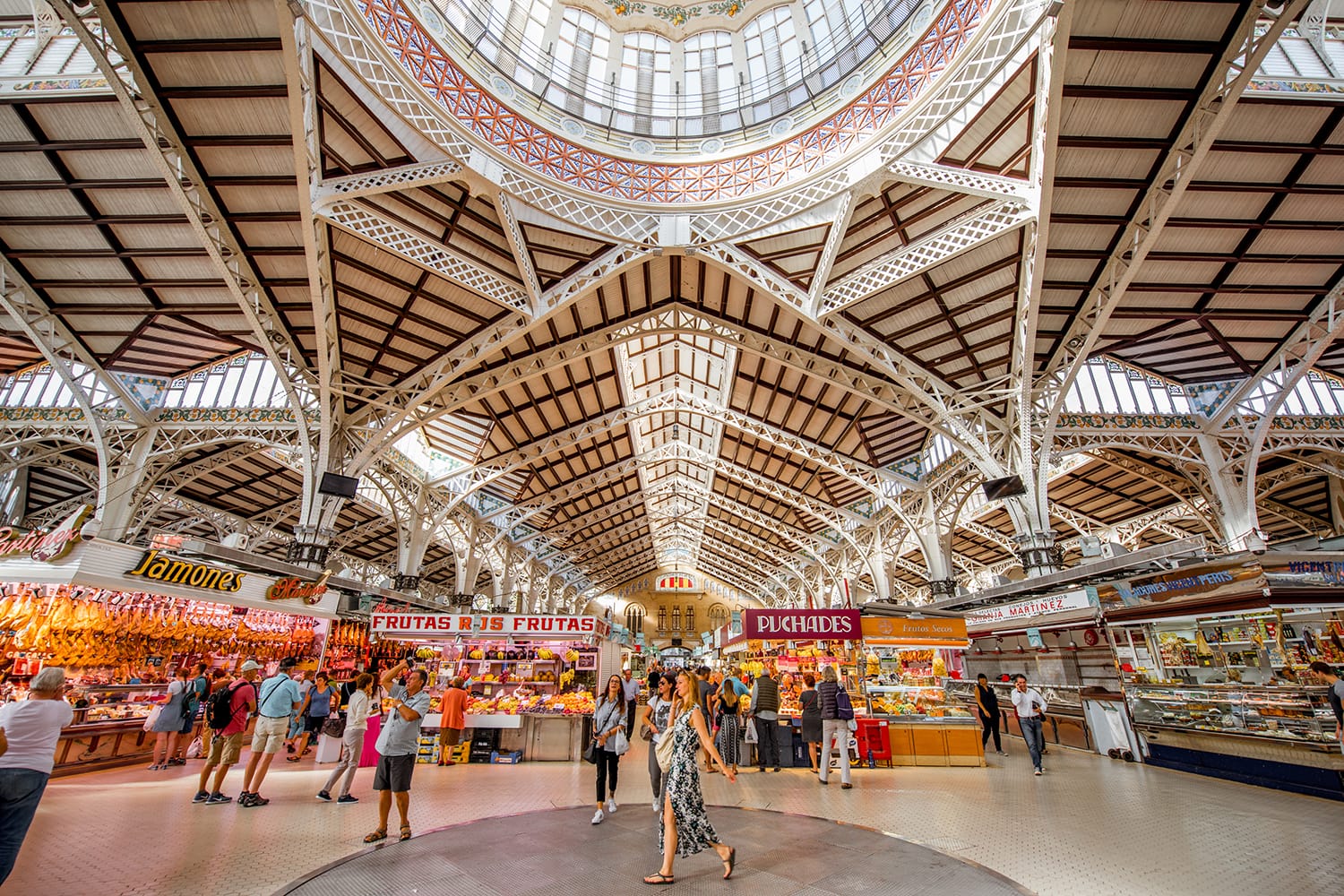
El Carmen
Next, it’s time to go for a wander in the Bohemian neighborhood of El Carmen in the Old Town’s northwest quarter. This part of the city is defined by its narrow, winding streets where you’ll have no trouble finding tapas bars, cafes, bars, and spots serving Valencian paella. It’s an interesting place to aimlessly explore, as El Carmen has a way of alternating between lively and quiet depending on the street. Exploring the district is also a good way to find entertaining graffiti and street art. All of this should be more than enough motivation to go for a wander.

Serranos Gate
Eventually, it’s time to find your way to the edge of the Old Town and track down the mighty Serranos Gate. One of several imposing gates that guard the entrance into the Old Town, the Serranos Gate once formed part of the city walls that surrounded Valencia. Built back in the 14th century, this Gothic gate is now a pair of bulky towers that mark the main northern entrance to the Old Town. The gate is also another place you can go if you’re after some rooftop views of the Valencia Old Town.

Flamenco Show with Dinner
Enjoy the best flamenco experience in Valencia at La Bulería. See all the magic of Spain in one unique show with the best artists, accompanied by the most authentic Mediterranean cuisine served in a beautiful restaurant of intimate and evocative atmosphere.
You can book your tickets to the Flamenco show here.
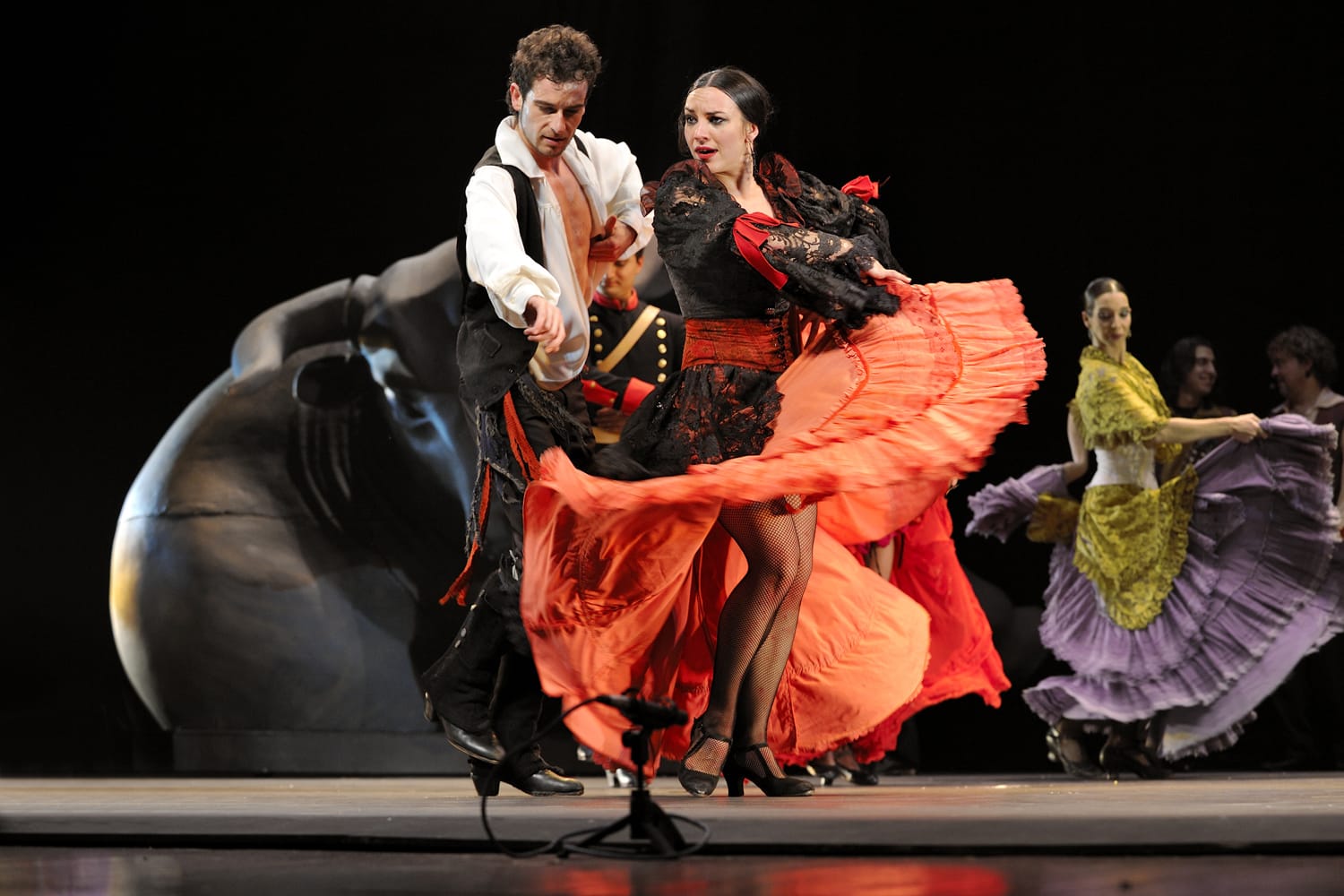
Valencia Itinerary: Day 2
With your second day you’re able to venture to other parts of Valencia, first seeing what the downtown area is like. From there it’s over to the futuristic City of Arts and Sciences and finally Valencia’s beachfront.
Plaza del Ayuntamiento
Begin another day in Valencia by making your way to the wide-open Plaza del Ayuntamiento at the southern end of the Old Town. This city square is a popular meeting place for locals and you’ll see why when you’re surrounded by its eclectic mix of grand architecture. The square’s main feature though is the City Hall of Valencia, a beautiful Neoclassical building that’s hard to miss even among its stunning neighbors.

Bullring of Valencia
Leaving the Old Town for now, venture into the downtown district of Eixample to see the Bullring of Valencia. While bullfighting events are only held at certain times of year, mainly March and July, this arena is well worth seeing year-round. Finished in 1859, it’s a stunning example of Neo-Mudéjar architecture, although there has been a bullring in this spot since the 11th century. You can actually learn more about the city’s relationship with bullfighting over at the Valencia Bullfighting Museum next door, with posters, costumes, and equipment on display.

Museu de Belles Arts
Traveling across town, make a beeline for the Museo de Bellas Artes, Valencia’s celebrated fine art museum. Located in the striking St. Pius V Palace, the museum is one of Valencia’s finest, thanks to its sizable collection. Inside the museum you’ll have the chance to see its sublime collections of local, Renaissance, and Gothic paintings, as well as to admire parts of the palace as you tour the building.

Jardín del Turia
One of the most curious features of Valencia is the great long park, Jardín del Turia, which divides the Old Town and downtown. That’s because this park is actually the former riverbed of the Turia river which once flowed through Valencia. The Turia was diverted in 1969 to prevent Valencia from flooding, and its old riverbed was repurposed rather brilliantly. It’s easy enough to believe a river flowed through here because of the many bridges that still cross the park. It’s a pleasant place to go for a walk and a relaxing way to head to Valencia’s modern City of Arts and Sciences.
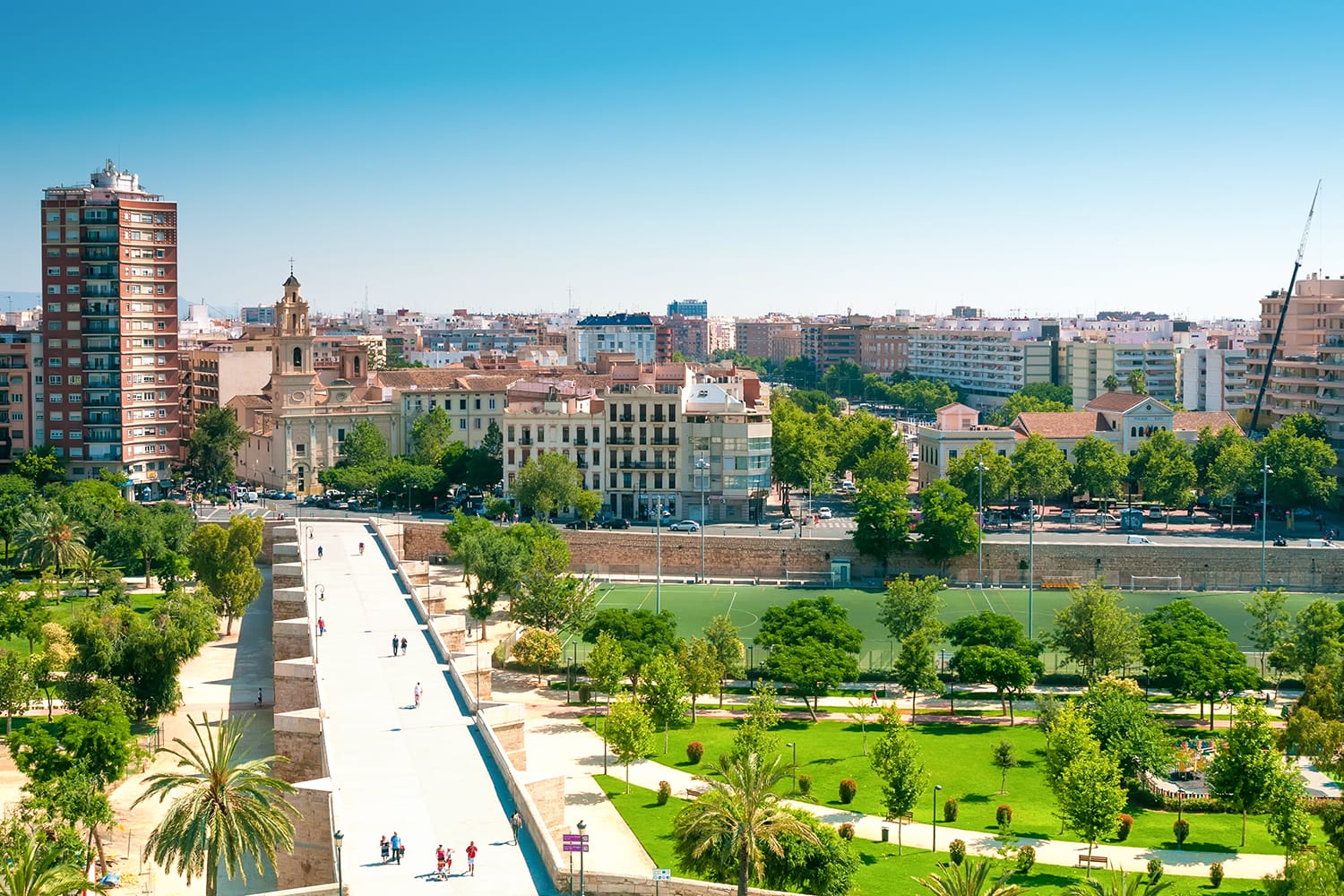
City of Arts and Sciences
Having seen Valencia’s historic side so thoroughly, it’s time to experience its modern one. Known as the City of Arts and Sciences, this large cultural complex at the end of the Jardín del Turia is full of ultra-futuristic buildings that need to be seen. Construction first began on the complex in 1996 and the last major building, the striking Palau de les Arts Reina Sofia arts center, was finished in 2005. Within the complex, among fountains and gardens, you’ll also find the Hemisfèric planetarium and IMAX theatre, and the Museu de les Ciències Príncipe Felipe science museum.
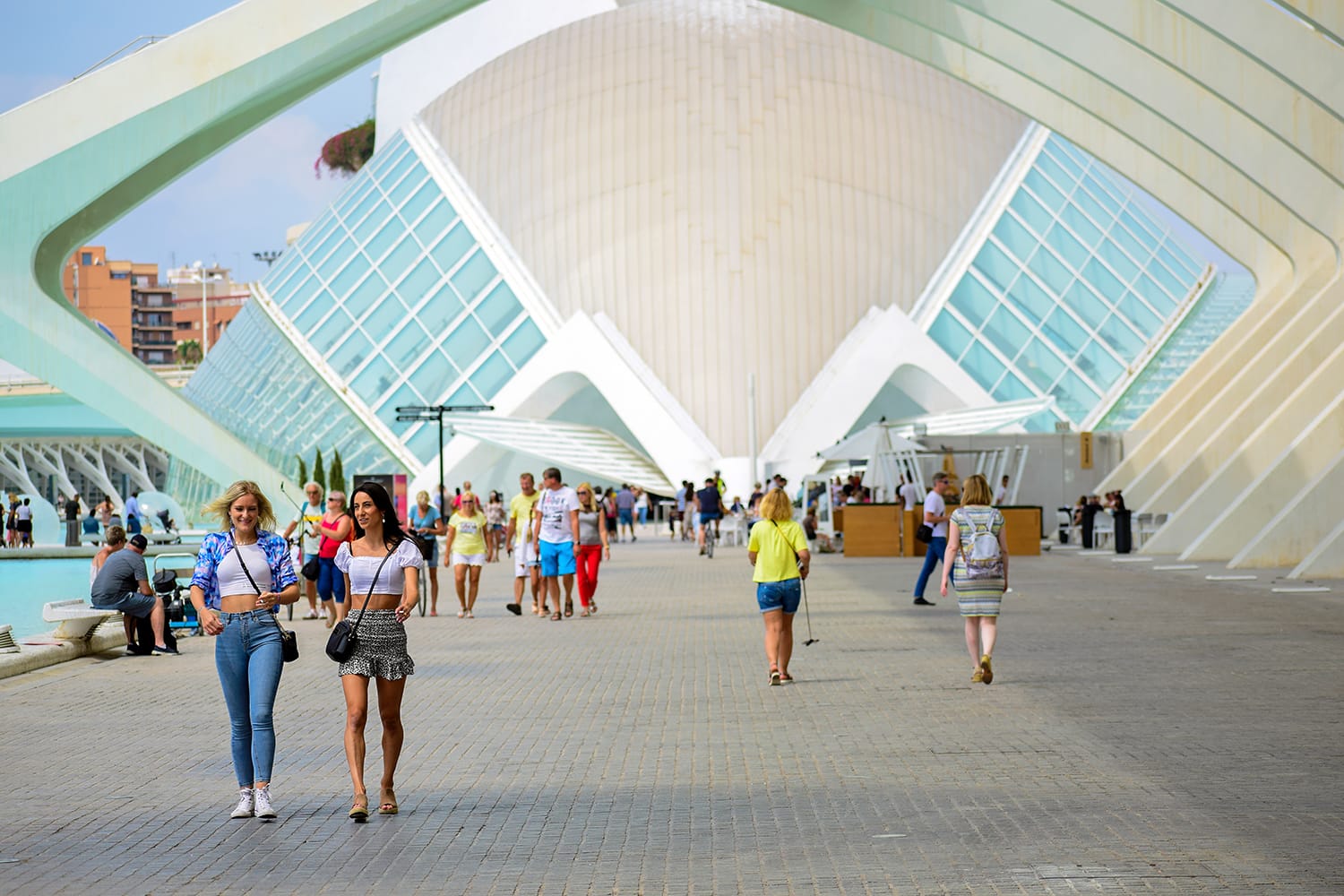
L’Oceanogràfic Aquarium
The other major attraction within the City of Arts and Sciences complex is L’Oceanogràfic, Valencia’s extremely popular oceanarium. It too has a hyper-modern building, but it’s the incredible array of marine life inside that makes it Spain’s most popular aquarium. Inside you’ll be able to walk through a glass tunnel with sharks floating over you and see sea life from different climates and regions. It even has some land-based animals, like penguins, seals, and walruses.
You can buy your entrance tickets to the L’Oceanogràfic Aquarium in advance here.

Playa de la Malvarrosa
Finish your time in Valencia by journeying all the way out to the coast for some beach time at Playa de la Malvarrosa. Running straight as an arrow for a kilometer this city beach is backed by palm trees and a pleasant seaside promenade. Even though the sun is in the wrong direction, the evening sky can be quite pretty over the beach. Plus, you don’t have to go far for bars and restaurants.
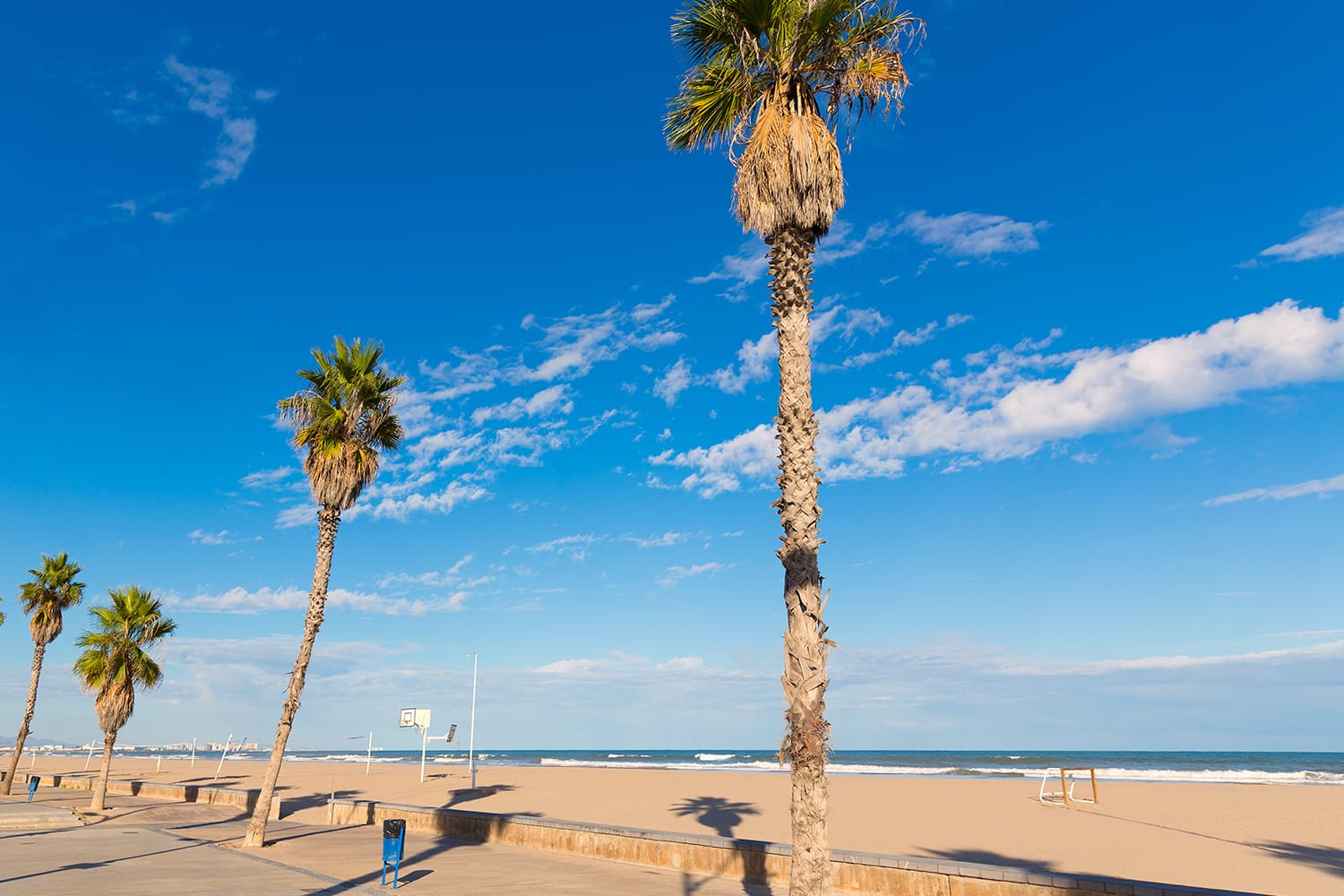
So there you have it – the ultimate Valencia itinerary with everything you need to know to comfortably spend 2 days in Valencia. You should now feel pretty confident about visiting this complex Spanish city and properly getting to know it.